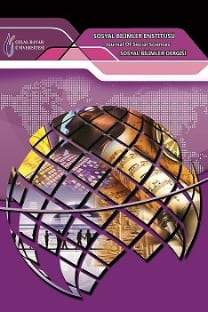Henri Lefebvre’nin Ritimanaliz Metoduyla T.S.Eliot’ın Şiirinin Yeniden Analizi
Bu çalışma, T.S. Eliot’ın ilk şiirleri ve The Waste Land’de tasvir edilen sosyal mekanın içindeki ritim elemanlarını ele almaktadır. Modernist dönemin önde gelen edebi şahsiyetlerinden biri olan Eliot, özellikle “The Lovesong of J. Alfred Prufrock”ta izlenebilecek olan üst-orta sınıf sınırları içinde yabancılaşmış bireyin temsilini ele almıştır. Çalışmanın teorik bağlamıyla ilgili olarak, Eliot’ın şehir hayatının ritimlerini nasıl gözlemlediğini, anladığını ve dinlediğini ortaya çıkarmak için Henri Lefebvre’nin Ritimanalizi teorisi uygulanmıştır. Eliot, şehrin kültürü içindeki insanları gözlemlerken, bu mekanda var olan mekanizmaları dinlemiştir. Ancak mekan ve ses konusundaki ilgisi, Eliot’ın tek bir yol izlemesine izin vermemiş, eserlerinin geniş, evrensel bir düzeye ulaşmasına olanak sağlamıştır. Sonuç olarak bu çalışma, Eliot’ın şiirlerindeki ritim algısını Lefebvre’nin Ritimanalizi perspektifinden ortaya koymayı amaçlamıştır.
Anahtar Kelimeler:
T.S.Eliot, The Waste Land, Sosyal Mekan, Ritimanaliz
Re-Visiting T.S. Eliot’s Poetry through Henri Lefebvre’s Rhythmanalysis
This paper explores the elements of rhythm in the social space in T.S. Eliot’s early poems and The Waste Land. One of the leading literary figures of the modernist era, Eliot dealt with the representation of the alienated individual within the boundary of the upper-middle class which can be followed especially in “The Lovesong of J. Alfred Prufrock.” Regarding the theoretical context of the study, Henri Lefebvre’s rhythmanalysis theory is applied to reveal how Eliot observed, understood and listened to the rhythms of city life. While observing people within the culture of the city, Eliot listened to the mechanisms present in this space. However, his concern of space and sound did not follow a single route, yet led to a wide, universal level. Thus, this paper intends to display Eliot’s perception of rhythm in his poems from the perspective of Lefebvre’s rhythmanalysis.
Keywords:
T.S. Eliot, Rhythmanalysis, Social Space, The Waste Land,
___
- Bresson, R. (1977). Notes on cinematography. New York: Urizen Books.
- Bush, R. (1983). T.S. Eliot: A study in character and style. New York: Oxford U. P.
- Chancellor, P. (1969). “The music of ‘The Waste Land.’” Comparative literature studies. 6.(1) 21-32.
- Chen, Yi. (2017). Practising rhythmanalysis: Theories and methodologies. London: Rowman and Littlefield International.
- Dayan, P. (2019). “How musical is Henri Lefebvre’s rhythmanalysis?” Rhythms now: Henri Lefebvre’s rhythmanalysis revisited. Eds. Steen Ledet Christiansen and Mirjam Gebauer. Aalborg University Press. Internet resource. 17-31.
- Elden, S. (2004). “Rhythmanalysis: An Introduction.” Rhythmanalysis: Space, Times and Everyday Life. London: Continuum. vii-xv.
- Eliot, T. S. (1948). Selected Essays. London: Faber and Faber.
- Eliot, T. S. (1963). Collected poems, 1909-1962. New York: Harcourt, Brace & World.
- Eliot, T. S. (1970). On Poetry and Poets. New York: Farrar, Straus & Giroux.
- Lefebvre, H. (1991). The production of space. Trans. Donald Nicholson-Smith. Oxford: Blackwell.
- Lefebvre, H. (2000). Writings on cities. Trans. Eleonore Kofman and Elizabeth Lebas. Malden: Blackwell.
- Lefebvre, H. (2002). Critique of everyday life. V.2: Foundations for a sociology of the everyday. Trans. John Moore. London: Verso.
- Lefebvre, H. (2004). Rhythmanalysis: Space, times and everyday life. Trans. S. Elden and G. Moore. London: Continuum.
- Lukacs, G. (1971). The theory of the novel: A historico-philosophical essay on the forms of great epic literature. Trans. Anna Bostock. Massachusetts: The MIT Press.
- Marshall, A. (2005). “England and nowhere.” The Cambridge companion to T.S. Eliot. Ed. A. David Moody. New York: Cambridge University Press. 94-107.
- Meyer, K. (2008). Rhythms, streets, cities. Space, difference, everyday life: Reading Henri Lefebvre. Eds. Kanishka Goonewardena, and et all. London: Routledge. 147-160.
- Murphy, R. E. (2007). Critical companion to T.S. Eliot: A literary reference to his life and work. New York: Facts On File.
- Nicolosi, R.J. (1980). “T. S. Eliot and music: An introduction.” The musical quarterly. 66(2), 192–204.
- Perkins, D. (1976). A History of Modern Poetry: From the 1890s to the High Modernist Mode. Massachusetts: Harvard U.P.
- Wilde, O. (2009). Complete Poetry. Ed. Isobel Murray. New York: Oxford UP.
- Williams, A. (1991). “Historical attitudes to women eating in restaurants.” Oxford Symposium on Food and Cookery 1991: Public Eating: Proceedings. Ed. Harlan Walker. London: Prospect Books, 311-314.
- Williamson, G. (1969). T.S.Eliot: A poem-by-poem analysis. New York: The Noonday Press.
- ISSN: 1304-4796
- Yayın Aralığı: Yılda 4 Sayı
- Başlangıç: 2003
- Yayıncı: Manisa Celal Bayar Üniversitesi
Sayıdaki Diğer Makaleler
Sosyal Medyada İşveren Çekiciliği: Çalışan Kullanımı Üzerine Nitel Bir Analiz
Tolga ŞENTÜRK, Murat Can BAŞARAN
Kamu Sektöründe Beşeri ve Sosyal Sermayenin Çalışan Performansı Üzerindeki Etkisi
Şerafettin ERTEN, İbrahim TÜRKMEN
Flört Şiddeti Ölçeği’nin Geliştirilmesi: Geçerlik ve Güvenirlik Çalışması
Nazire Burçin HAMUTOĞLU, Gözde SEZEN-GÜLTEKİN, Mübin KIYICI
İlkokul 4. Sınıf Ders Kitaplarındaki Soruların TIMSS 2019 Bilişsel Alanlarına Göre Analizi
COVID – 19 Pandemisi ve Azerbaycan Ekonomisi: Zor Zamanlarda Politika Dersleri
Kriz Yönetimi ile Çalışan Performansı Arasındaki İlişkide Paternalist Liderin Aracı Etkisi
